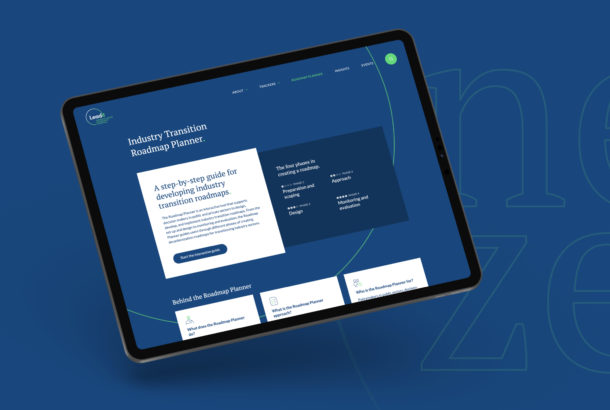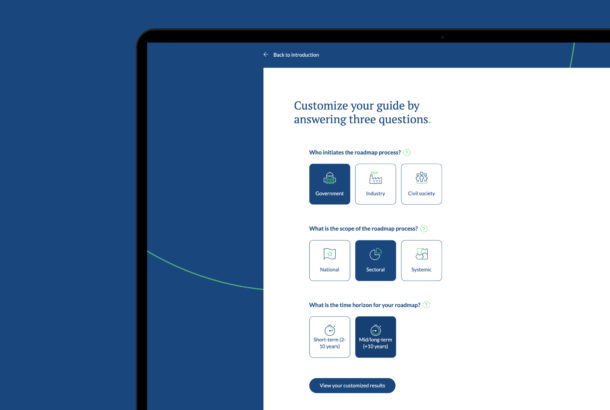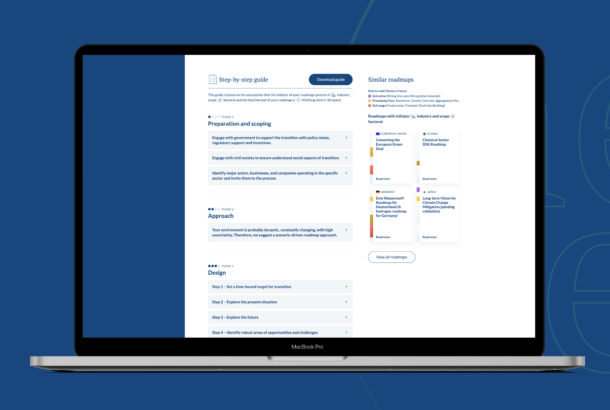The new Roadmap Planner helps decision-makers move from ambition to implementation.
The new Roadmap Planner guides decision-makers in public and private sectors through different phases of creating industry transition roadmaps. Somya Joshi and Felipe Sanchez (LeadIT) explain how the interactive tool can support its users in designing, developing, and implementing decarbonization roadmaps for industry sectors.

What are roadmaps?
Felipe Sanchez: Decarbonization roadmaps are also known as implementation plans, visions or strategies and they are actionable strategic plans that set out measures and desirable targets to decarbonize industry. Roadmaps normally start with a predetermined end target and contain the necessary steps – including measures on finance, public-private partnerships, innovation and policies – that are needed to transform industries and reach the targets that have been set out.
Somya Joshi: Roadmaps are very much context-specific, so there are many different types of roadmaps. But if you look at industry transition roadmaps, it’s important to set tangible and achievable targets that are in line with the nationally defined targets within the context of your country, industry and sector and what has already been committed to. When you already have that vision and goal, the question is, how do we get there in a practical and efficient way? A good roadmap will help you simulate the process and realize where you are likely to get stuck and where you need to have some additional policy levers in place to accelerate the transition. In the case of industry decarbonization and transition, the roadmaps are very reliant on multiple sectors, and an effective roadmap will provide pathways to intersect across these sectors.
For more information about roadmaps, read “What are industry transition roadmaps?”
What is the Industry Transition Roadmap Planner?
Somya Joshi: The Roadmap Planner is an interactive tool that supports decision-makers in public and private sectors to design, develop and implement industry transition roadmaps. Our impression was that there was very little out there to help ambitious industry transition actors to actually implement and design an operational pathway, which would also offer guidelines on how to monitor the roadmapping process and see if the measures are really being followed or if there are any gaps. Along the way of working industry transition roadmaps, we spotted this gap as the methodology was missing. We wanted to formalize the methodology part so we could apply the same comparable set of inputs and outputs and use it in different contexts. The idea behind the Roadmap Planner is to get actors from different sectors to sit together at the same table and design roadmaps together.
Felipe Sanchez: The main audience we had in mind when we started designing a roadmapping tool was the people who actually initiate the roadmapping processes. What we are trying to do by creating an interactive tool like the Roadmap Planner is to facilitate the roadmapping process for them and the dialogue between different actors. Our hope is that the tool could be used equally by the three stakeholder groups that we have identified: government actors, industry actors and civil society.
How does the Roadmap Planner work?

Somya Joshi: When using the Roadmap Planner, the user can navigate between different choices and select the choices that are relevant for them, such as which sector they are from or what type of roadmap they want to have. After the relevant choices have been made, the user will receive a PDF that gives them an idea of what the roadmap will look like. One thing to note here is that the final output of the tool is not a complete roadmap. It is more a set of guidelines that will help the user make that roadmap. That is a key difference because what we wanted was to design something that would be helpful that people can then take to their team leads or to the broader context in which they are working and say, ”This is roughly the kind of roadmap we are interested in.” The idea is for them to make it themselves in a collaborative way so they can design a roadmap that fits their needs and in doing so have greater ownership of the process. By placing the stakeholders in the driving seat here, our hope was that this approach would generate more buy-in when it comes to implementation.
The actual graphic interface and tool design was led by Data Design, the data visualization agency that we worked with on the Transition Tracker. The tool is designed so the users put in the parameters they want and then they receive the output immediately, so we do not store any information about users. If the process is followed in a robust way, what you will have in the end is a set of guidelines, a set of instructions, on how to reach your industry transition targets.
How can an interactive tool support the roadmapping process?
Somya Joshi: Roadmapping is a very dynamic process that involves a lot of different stakeholders who often come to the table with different agendas, different languages and ways of communicating. The process can be very tricky, because you can get stuck in so many areas, whether it is the financial aspect or the regulatory or legislative aspects. It could be a policy thing or simply just because the technology is not there. There are so many potential roadblocks, so the Roadmap Planner provides both a constructive process and it provides guidance on how to navigate some of these roadblocks. It is an opportunity for people who might not normally talk to each other to sit across the same table and share knowledge and past experiences. I think that was the underlying intention behind this tool all along, to facilitate that kind of critical conversation amongst stakeholders.
Felipe Sanchez: One thing that we have noticed that is often forgotten about, for example, is the monitoring and evaluation part and we think it is a very important part of the process. Even in the broader context of climate action, monitoring and evaluation is really important to having some sense of accountability as we all move from climate ambition to implementation. The Roadmap Planner makes sure that when users are designing a roadmap, they take that aspect into consideration. The Roadmap Planner can help users in that sense by reminding them to think about some of these aspects from the beginning, so it’s not an afterthought. The Roadmap Planner also adds value by providing a starting point. There is a lot to be said about not having to start from scratch every time you go to a new setting, a new country and new actors, so that is one of the benefits of the tool as well.

Somya Joshi: The Roadmap Planner can support with everything from setting the time frame, for example, to guidelines on the many complex parameters. The interactive tool facilitates decision-making within the process by making the users think about whether it is a short-term process that they are looking at within a couple of years or if it is a longer-term process. The tool helps users think about whether they want to have a scenario-driven approach, where things can change in a very volatile way, or if they want to apply a classic roadmapping process, where it is more or less predictable. It will give you some recommendations on what is more suitable for a specific case. Another key aspect of this tool is that it gives you examples to look at for each step. It can show other roadmaps from other countries and sectors, for example, while notifying users that there are similar roadmaps that could be interesting for them to look at. This relates to what Felipe said: nobody wants to start from scratch. We offer the users the possibility to look at what has already been tested, so it provides this reference point as they are going along.
What is the ambition for the Roadmap Planner in the future?
Somya Joshi: When we designed this, we had a process in mind of course. We envisioned how we could make it as meaningful as possible, but when it is actually tested, we realize that there are so many other parameters that we could consider that actually play a role in how successful the roadmapping process will be. Right now, it is still early days for the tool and we would like to get it tested more in different settings. For example, we will have a workshop in India where we will use the tool and although the people that will be using it come from a very diverse range of contexts since the workshop will include everything from heavy industry CEOs to policymakers and civil society organizations, we hope that it can be useful for all of them. This will be a good test of the tool in a live setting to see how it can help and where it can be improved. The ambition is to have a couple of these trial rounds and make it more instrumental in the creation of national or sectoral roadmaps. Next year will be all about fine-tuning it.
Felipe Sanchez: If we are talking about the more long-term ambition with this, I suppose one ambition will be that this tool can be used for fulfilling the commitments that were set out at the LeadIT Summit and used more generally as we move from climate ambition to climate action. At the Summit, the countries and companies came to an agreement and they should create or update their own roadmaps, so we hope that this tool can be helpful in that respect.
Somya Joshi: Right now, we are finding that a lot of nations and companies are signing up for these net-zero pledges and they feel the pressure to commit to it. On how they are going to get there, there is relative ambiguity as they are really struggling to operationalize some of those commitments. Ideally, something like this would be helpful for them to make those commitments happen. We hope that it can both be a tool for implementation and a tool for accountability, as well as a tool for evaluating where the gaps are. We hope it can help users ask critical questions, like where are we falling short? What could we do better? As Felipe emphasized, we are moving from the phase of agenda setting to actual implementation now and this is sometimes called “the final decade of action”, so our hope is that the Roadmap Planner can facilitate that transition.
"We hope that it can both be a tool for implementation and a tool for accountability, as well as a tool for evaluating where the gaps are."
Somya Joshi
Roadmaps Lead, LeadIT Secretariat
